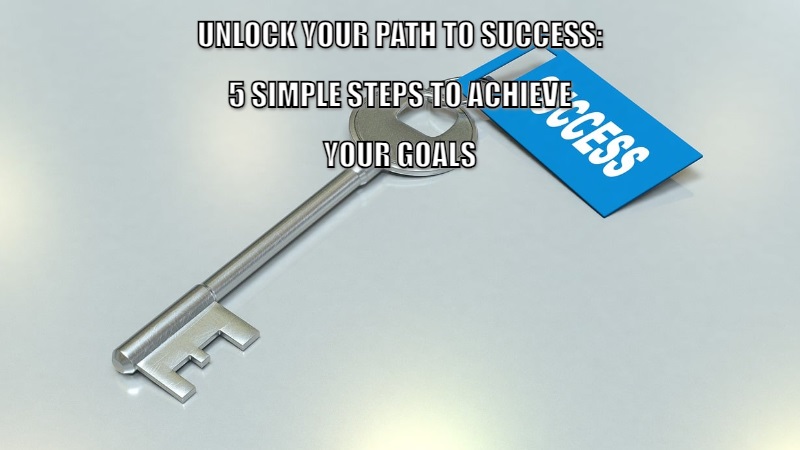Unlock Your Path to Success: 5 Simple Steps to Achieve Your Goals
Introduction
Success plays a significant role in people’s lives, serving as a driving force for personal growth and fulfillment. However, success is a subjective concept, varying from one individual to another. In this article, we will explore five simple steps that can assist you in unlocking your path to success, regardless of how you define it.

Step 1: Setting Clear Goals
Understanding the power of goal-setting
Setting clear goals is a fundamental aspect of achieving success. By clearly defining your objectives, you provide yourself with a roadmap to follow. Goals serve as guiding posts, keeping you focused and motivated along your journey. Whether your aspirations are related to your career, relationships, or personal development, establishing clear goals is the first step in turning your dreams into reality.
The art of setting SMART goals
To ensure your goals are practical, it is crucial to make them SMART. SMART goals are specific, measurable, achievable, relevant, and time-bound. This framework helps to define your objectives with precision and creates a sense of accountability. To set SMART goals, consider these practical tips:
- Be specific about what you want to achieve.
- Set measurable benchmarks to track your progress.
- Ensure your goals are realistic and attainable.
- Align your objectives with your broader aspirations.
- Assign deadlines for each milestone to maintain focus and drive.
Visualizing success
Beyond setting clear goals, visualization can significantly enhance your path to success. By imagining yourself already achieving your desired outcome, you create a powerful mental image that reinforces your motivation and belief in your abilities. To incorporate visualization into your daily routine, consider these techniques:
- Take time each day to visualize your success in detail, imagining how it feels, looks, and sounds.
- Utilize vision boards or digital collages to represent your goals and aspirations visually.
- Engage all your senses when visualizing success, making the experience more vivid and impactful.
Step 2: Developing a Growth Mindset
The power of mindset
A growth mindset plays a crucial role in achieving success. Adopting a growth mindset means believing in your ability to grow, learn, and improve over time. This mindset allows you to embrace challenges, persist in the face of setbacks, and ultimately reach your highest potential.
Overcoming self-limiting beliefs
Often, self-limiting beliefs act as barriers to success. These limiting thoughts can undermine your confidence and impede your progress. Overcoming them requires active self-reflection and the willingness to challenge and reframe negative thoughts. Here are strategies to help you overcome self-limiting beliefs:
- Recognize and acknowledge your self-limiting beliefs.
- Challenge them by seeking evidence that contradicts these beliefs.
- Replace negative self-talk with positive affirmations and empowering statements.
- Surround yourself with supportive individuals who uplift and encourage your growth.

Embracing failure as a learning opportunity
Failure is an inevitable part of any success journey. However, rather than perceiving failure as a permanent setback, successful individuals view it as an opportunity to learn and grow. Embracing failure requires a positive attitude and a willingness to analyze mistakes and extract valuable lessons. To bounce back from failures effectively:
- Adopt a growth mindset that embraces failure as a stepping stone to success.
- Study the reasons behind your failures and identify areas for improvement.
- Seek inspiration from those who have transformed failures into remarkable achievements.
- Use failures as motivation to strive harder and refine your approach.
Step 3: Taking Massive Action
Vision without action is merely a dream
While having a clear vision is necessary, it is taking action that drives progress and brings your goals to life. Without action, your aspirations remain dormant. Overcoming procrastination and increasing productivity are essential in transforming your dreams into tangible achievements. To take massive action:
- Break down your goals into smaller, actionable steps.
- Prioritize your tasks to maintain focus and avoid feeling overwhelmed.
- Set deadlines for each task to create a sense of urgency.
- Eliminate distractions and create a conducive environment for productivity.
- Celebrate small wins to stay motivated and committed.
Building effective habits
Successful individuals understand the influence of habits on long-term success. Developing and nurturing productive habits is paramount to maintaining consistency and progress. Here are techniques to help you build effective habits:
- Start small and gradually introduce new habits into your routine.
- Utilize habit trackers or apps to monitor your progress.
- Consistently practice your desired habits to reinforce their integration into your daily life.
- Surround yourself with individuals who embody the habits you wish to cultivate to stay motivated.
Seeking mentorship and learning from experts
Seeking guidance and mentorship from those who have already achieved success in your desired field can dramatically accelerate your growth. Mentors provide valuable insights, guidance, and motivation, helping you navigate challenges and avoid pitfalls. Consider these practical tips when seeking mentors:
- Identify individuals who have achieved the level of success you aspire to attain.
- Attend networking events and conferences to connect with potential mentors.
- Be courteous and respectful when reaching out to experts, highlighting your eagerness to learn.
- Cultivate relationships by providing value and expressing gratitude for their mentorship.
Step 4: Cultivating Resilience and Perseverance
The mindset of resilience
Resilience is an indispensable trait when navigating the path to success. It involves bouncing back from failures, adapting to challenges, and maintaining a positive attitude despite setbacks. Cultivating resilience ensures that you remain steadfast on your journey. Strategies for developing resilience include:
- Embrace challenges as opportunities for growth and transformation.
- Cultivate a positive mindset that reframes setbacks as temporary obstacles.
- Practice self-care and seek support from loved ones during challenging times.
- Learn from past adversities and allow them to enhance your strength and resilience.

Nurturing perseverance
Perseverance is the key to overcoming obstacles and achieving long-term goals. Success rarely comes overnight, and staying committed and motivated throughout the journey is crucial. To nurture perseverance:
- Remind yourself of the importance and value of your goals.
- Break down long-term goals into smaller, manageable milestones.
- Stay inspired by surrounding yourself with success stories and motivational content.
- Keep a journal to document your progress and reflect on how far you’ve come.
Adapting to change and embracing failure
Change is inevitable on the path to success. Rather than resisting it, successful individuals adapt and capitalize on opportunities that arise from change. Embracing failure goes hand in hand with adaptability. When you view failure as a lesson rather than a permanent setback, you unlock your ability to learn, grow, and make necessary adjustments along the way.
Step 5: Continuous Learning and Personal Development
Lifelong learning mindset
In the pursuit of success, a mindset of lifelong learning is essential. Continuous learning fosters personal growth, expands knowledge, and enhances your capabilities. By embracing this mindset, you position yourself for ongoing success. Consider the following aspects of lifelong learning:
- Stay curious and open-minded, actively seeking new knowledge and perspectives.
- Engage in various learning mediums, such as books, podcasts, courses, and workshops.
- Attend seminars and conferences related to your field to stay updated on industry trends.
- Participate in networking events to gain insights from other professionals.
Expanding knowledge and skills
To achieve success, continuously expanding your knowledge and skill set is crucial. Seek opportunities to acquire new skills, enabling you to adapt to evolving circumstances and remain competitive. Consider these methods to expand your expertise:
- Engage in online learning platforms to access courses and training programs relevant to your field.
- Join professional associations or organizations that offer opportunities for skill development.
- Allocate time for self-study and independent research to broaden your knowledge.
- Attend workshops or seminars conducted by industry experts.
Practicing self-reflection and self-improvement
Self-reflection serves as a compass for personal growth and development. By regularly assessing your progress, strengths, and areas for improvement, you can identify opportunities to refine your strategies and approach. Techniques for self-reflection and self-improvement include:
- Set aside time for introspection and self-analysis.
- Maintain a journal to document your thoughts, insights, and reflections.
- Seek feedback from trusted individuals who can provide constructive criticism.
- Actively seek opportunities for personal development, such as attending workshops or seeking mentors.
Summary
Achieving success is within your grasp if you follow these five simple steps:
- Set clear goals using the SMART framework, and visualize your success.
- Develop a growth mindset, challenge self-limiting beliefs, and embrace failure as a learning opportunity.
- Take massive action, build effective habits, and seek mentorship.
- Cultivate resilience, nurture perseverance, and embrace change.
- Adopt a mindset of continuous learning, expand your knowledge and skills, and practice self-reflection and improvement.
Remember, success is a journey, and by implementing these steps, you can unlock your true potential and achieve the success you deserve.
FAQs (Frequently Asked Questions)
Q: How long does it take to achieve success using these steps?
A: The timeline for success varies for each individual. It depends on factors such as the complexity of your goals, your commitment, and external circumstances. Remember that success is a continuous process, and the journey itself is as important as the destination.
Q: What if I encounter setbacks and failures along the way?
A: Setbacks and failures are inevitable on the path to success. Embrace them as opportunities for growth, learn from them, and use them as stepping stones towards achieving your goals.
Q: Can I achieve success without seeking mentorship?
A: While mentorship is not a prerequisite for success, it can significantly accelerate your progress. Mentors provide valuable guidance, insights, and encouragement, helping you navigate challenges and avoid common pitfalls.
Q: How often should I practice self-reflection?
A: The frequency of self-reflection depends on your individual needs and preferences. Some individuals benefit from daily self-reflection, while others may find it more beneficial on a weekly or monthly basis. Experiment with different intervals to find what works best for you.
Q: Is continuous learning necessary even after achieving success?
A: Absolutely. Continuous learning ensures personal growth, expands your horizons, and keeps you adaptable in an ever-changing world. Even after achieving success, ongoing education and personal development are crucial for maintaining your competitive edge and sustaining success in the long run.


